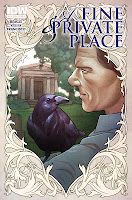Womanthology: Space #1
by Bonnie Burton, Sandy King Carpenter, Alison Ross, Stephanie Hans, Ming Doyle, Stacie Ponder, Jessica Hickman, Rachel Deering, Tanja Wooten, Stephanie Hans, Ming Doyle, Jordie Bellarie, Stacie Ponder
Anthology projects tend to be a mixed bag, and this is especially true when the contributors have a small page count to work with. Sophomore outing Womanthology: Space is no exception. Most of the five stories featured don't quite succeed in mastering this most stringent of comic formats.
The opening story "Waiting for Mr. Roboto" by Bonnie Burton and Jessica Hickman is pretty disappointing. An overlong gag about an alien waitress working at a space diner run by robots, hoping to be swept off her feet by a handsome scoundrel. The lackasaisical pacing doesn't quite bring the punchline home, and Hickman's artwork is more stiff than cute.
Similar issues are found in "Dead Again," by Sandy King Carpenter and Tanja Wooten. A gothic horror set in a derelict space station. The tale of a man haunted by the ghost of the woman he loves is supposed to pack emotional punch, but struggles to tell a fuller story while working against the limited page count. It does have some lovely panels drawn in a rough style by Wooden.
"Scaling Heaven" by Alison Ross and Stephanie Hans resolves the issue by telling what could be described as the opening to a longer political saga. Portraying a new Space Race between China and the United States to place the first woman on the moon, the story focuses on the parallel preparations of the two women protagonists as a microcosm of the larger geopolitical conflict. But more than that, the imagery and speech patterns nostalgically evokes the spirit of exploration found in the old Space Race.
The anthology finishes with a pair of two-pagers.The first of them, "The Adventures of Princess Plutonia" by Ming Doyle, is an inversion of the classic space opera trope in which the handsome hero rescues the alien princess. The familiar subject is complimented by the retro-stylings of Doyle's art and Jordie Bellaire's colors. This pared down story can be thought of as the Sunday edition of an ongoing newspaper cartoon strip.
The same could be said of "Space Girls" by Stacie Ponder. A homage/parody of Star Trek and similar shows, the story has barely begun before it cuts off. Cuter than this comic's opening act, but still a somewhat weak bookend to the anthology.
Happy! #1
by Grant Morrison, Darick Robertson, Richard P. Clark, Simon Bowland, Michael Allred
Grant Morrison's latest project Happy! could be described as crime fiction meets fantasy. It could be compared to concurrent series Fatale, but the latter's fantasy elements are closer to classic horror, while those of the former come from children's television. Nicholas Sax is a former police detective turned mob hitman. And he's reviled on both sides of the law. The story opens with two mob members sent out to eliminate Sax. Sax survives, but now he's wanted by both the cops and the mob for in formation he doesn't actually have. He evades capture with the help of a small talking, flying blue cartoon unicorn invisible to everyone but him. Is he hallucinating, like the hero of Joe the Barbarian?
This is a strange comic, not just for its premise. The crime elements are a departure from Morrison's more well known work with sci-fi and capes. His portrayal of the criminal underworld is harsh with its attendant violence and non-stop swearing. Sax is a completely unsympathetic character. So it's odd to have him suddenly communicating with an adorable cartoon animal like he's starring in an edgier version of a Disney Studios movie. It's hard to say if the eventual payoff will be worth the story. But it's interesting to see that this is territory Morrison chose to explore when working on creator-owned comics.
(I admit that I was also thrown by the comic using the same title to the Naoki Urasawa manga)
A Fine and Private Place #1
by Peter Gillis, Eduardo Francisco, Priscilla Tramontano, Shawn Lee
Original story by Peter S. Beagle
A general rule of thumb of mine is that comic book adaptations of novels will invariably be compromised from having to translate the original prose into the medium's word/image mix. I haven't read the original A Fine and Private Place novel. But this nonetheless seems to be a fairly streamlined and smooth adaptation of the source material. The prose that does survive in comic book form is still the main draw. Eduardo Francisco's art is straightforward and doesn't get n the way of the story. But I'm not sure if it's enough of a draw to recommend it over the novel.
The comic is dominated by dialogue. Jonathan Rebeck is a man who secretly squats in a cemetery mausoleum. He normally shuns human contact, but somehow can communicate with the cemetery's ravens and the ghosts of the recently deceased. The comic's centerpiece is a conversation between him and a dead young man who was poisoned by his wife, which is interrupted by a widow visiting her husband's grave. Rebneck makes for an intriguing individual, willing to listen to anyone despite his unusual living circumstances. The comic book version strangely resembles Jack Kirby. If the reader enjoys quiet introspection about existential questions, this comic is worth the read. But it probably will be most appreciated by fans of the original work.



